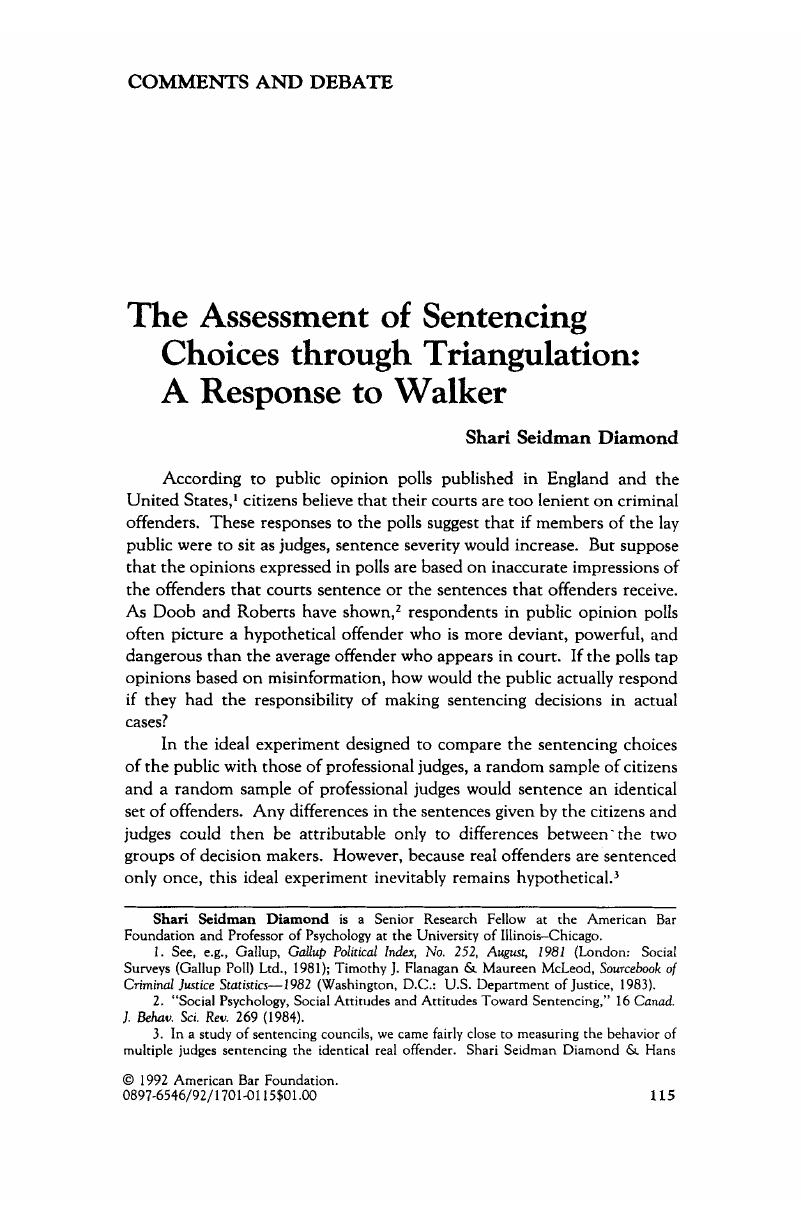Published online by Cambridge University Press: 27 December 2018

1 See, e.g., Gallup, Gallup Political Index, No. 252, August, 1981 (London: Social Surveys (Gallup Poll) Ltd., 1981); Timothy J. Flanagan & Maureen McLeod, Sourcebook of Criminal Justice Statistics—1982 (Washington, D.C.: U.S. Department of Justice, 1983).Google Scholar
2 “Social Psychology, Social Attitudes and Attitudes Toward Sentencing,” 16 Canad. J. Behav. Sci. Rev. 269 (1984).CrossRefGoogle Scholar
3 In a study of sentencing councils, we came fairly close to measuring the behavior of multiple judges sentencing the identical real offender. Shari Seidman Diamond & Hans Zeisel, “Sentencing Councils: A Study of Sentence Disparity and its Reduction,”43 U. Chi. L. Rev. 109 (1976). We studied sentencing councils in two U.S. federal district courts in which judges received case dossiers for offenders who were awaiting sentence, wrote down their sentence recommendations, and then met on a weekly basis to discuss those recommendations. The trial judge retained ultimate sentencing authority, but the consulting judges knew that their recommendations could and often did have a real impact on the sentence actually imposed.Google Scholar
4 Campbell, Donald T. & Fiske, Donald W., “Convergent and Discriminant Validation by the Multitrait-multimethod Matrix,” Psychological Bull. 56 81 (1959).Google ScholarPubMed
5 See Feigl, Herbert, “The Mental and the Physical,” in H. Feigl, M. Scriven, and G. Maxwell, eds., 2 Minnesota Studies in the Philosophy of Science (Minneapolis: University of Minnesota Press, 1958).Google Scholar
6 Diamond, Shari Seidman, “Revising Images of Public Punitiveness: Sentencing by Law and Professional English Magistrates,” Law & Soc. Inquiry. 15 191 (1990).CrossRefGoogle Scholar
7 See Lockhart v. McCree, 476 U.S. 162 (1986); for a discussion of Justice Rehnquist's failure to recognize the power of corroborative evidence in providing convergent validation, see Phoebe C. Ellsworth, “Unpleasant Facts: The Supreme Court's Response to Empirical Research on Capital Punishment,” in K. C. Haas & J. Inciardi, eds., Adjudicating Death: Moral and Legal Perspectives on Capital Punishment (Beverly Hills, Cal.: Sage Publications, 1988).Google Scholar
8 Sentencing the Motoring offender (London: Heinemann, 1972); see also, e.g., Andreas Kapardis, “Magistrates' Opinions, Characteristics, and Sentencing,” 145 Justice of the Peace 289 (1981).Google Scholar
9 Shari Seidman Diamond & Loretta J. Stalans, “The Myth of Judicial Leniency,” 7 Behav. Sci. & Law 73 (1989); Shari Seidman Diamond, “Revising Images of Public Punitiveness,” 15 Law & Soc. Inquiry 191 (1990).CrossRefGoogle Scholar
10 For a discussion of the limitations of simulation in another context, see 3 Law & Hum. Behav. (1979), Special Issue: Simulation Research and the Law (ed. Shari Seidman Diamond).Google Scholar
11 The problem of adjusting for biases in sample selection is well-known in social science research and there is substantial controversy over proposed solutions. See, e.g., James J. Heckman, “Simultaneous Equation Models with Continuous and Discrete Endogenous Variables and Structural Shifts,”in S. Goldfeld & R. Quandt, eds., Studies in Nonlinear Estimation (Cambridge, Mass.: Ballinger. 1976); Ross M. Stoltzenberg & D. A. Relles, “Theory Testing in a World of Constrained Research Design: The Significance of Heckman's Censored Sampling Bias Correction for Non-experimental Research,” 18 Sociological Methods & Research 395 (1990).CrossRefGoogle Scholar
12 A further difference can arise in England where the magistrates can decline to hear “triable-either-way” offenses and send them instead to Crown Court for trial.Google Scholar
13 To obtain a large sample of cases, we did not observe sessions in which trials were scheduled.Google Scholar
14 She does suggest incorporating whether the offender was sentenced after a guilty verdict or a trial. The observed cases included fewer than 5% in which the observers were able to learn that the offender previously had been found guilty in a trial.Google Scholar
15 Some case characteristics could not be assessed in the archival study (e.g., did the offender express remorse?) and others were not relevant for the archival study of burglary and theft (e.g., was the offense violent?). The archival study of burglary did include a proxy variable (was the victim a person?) that distinguished burglary of a dwelling from the burglary of another establishment. Walker apparently missed this variable in suggesting that an explanation for the greater lay leniency in the burglary cases might have been “the nature of the property entered (i.e., a dwelling house)” (at 111).Google Scholar
16 See, e.g., Hagan, John, Ilene Nagel, & Celesta Albonetti, “The Differential Sentencing of White Collar Offenders in Ten Federal District Courts,” 45 Am. Soc. Rev. 802 (1980).CrossRefGoogle Scholar
17 See research discussed in Catherine Fitzmaurice & Ken Pease, The Psychology of Judicial Sentencing ch. 5 (Manchester: Manchester University Press, 1986) (“Fitzmaurice & Pease, Psychology of Judicial Sentencing”).Google Scholar
18 Because an error in the footnote in Appendix A, Table A1 said that the measure of offense severity used the percentage of cases sent to Crown Court for sentencing rather than for trial, Walker notes that the severity levels reported in the text are impossibly low. She is correct, and I am grateful that her close reading gave me the opportunity to make this correction.Google Scholar
19 The severity level of robbery was computed as follows: 3,154 committed for trial/(3,957 proceeded against — (14 against whom proceedings were discontinued and 119 who were discharged under sec. 7 of the Magistrates' Courts Act 1952)) = .82. Similarly, the severity level of shoplifting was computed as follows: 4,350/((79,022 — (311 + 95)) = .06.Google Scholar
20 See, e.g., Fitzmaurice & Pease, Psychology of Judicial Sentencing (cited in note 17); Howard Parker, Maggie Sumner, & Graham Jarvis, Unmasking the Magistrates (Philadelphia: Open University Press, 1989).Google Scholar
21 Andreas Kapardis & David P. Farrington, “An Experimental Study of Sentencing by Magistrates,” 5 Law & Hum. Behav. 114 (1981).CrossRefGoogle Scholar
22 Brian Harris, “Sentencing Guidance in the Magistrates' Courts,” in Martin Wasik &. Ken Pease, eds., Sentencing Reform: Guidance or Guidelines 70 (Manchester: Manchester University Press, 1987).Google Scholar
23 See studies cited at note 8 in Diamond, 15 Law & Soc. Inquiry 191 (cited in note 6).Google Scholar
24 Id. at 208–18.Google Scholar
25 Lawrence M. Friedman, “The Law and Society Movement,” 38 Stan. L. Rev. 763 (1986).CrossRefGoogle Scholar